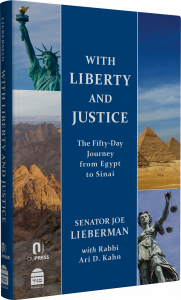Excerpted from With Liberty and Justice: The Fifty-Day Journey from Egypt to Sinai by Senator Joe Lieberman with Rabbi Ari D. Kahn, co-published by OU Press and Maggid Books
 Day 45 – Ruth, A Love Story and an Allegory
Day 45 – Ruth, A Love Story and an Allegory
Most Jewish communities read the Book of Ruth during morning services on Shavuot. A beautiful, romantic story, it fittingly reflects the rabbinic view that the giving of the Ten Commandments and their acceptance was like a marriage ceremony between God and the Israelites.
The Book of Ruth begins with a man named Elimelekh, who, when famine strikes Israel, uproots his family from their hometown of Bethlehem and leaves his country and people behind.
The names of the characters and places in the book of Ruth are instructive, indicative even of divine justice. Elimelekh leaves behind the city of Bethlehem – Hebrew for “house of bread.” Ironically, as the story opens, there is no leĥem, “bread,” in Bethlehem. According to the Midrash, Elimelekh, who was wealthy, apparently abandoned his town to protect his fortune from the appeals of suffering neighbors. He takes his wife, his sons, and his wealth to the Plains of Moab. Soon afterward, Elimelekh dies; his sons Mahlon, a name meaning “diseased one,” and Kilion, “eradicated one,” marry Moabite women, and they too die.
Elimelekh’s widow, Naomi, decides to return to Israel. Initially, both of Naomi’s daughters-in-law offer to return with her, but Naomi presents them with the harsh realities that argue against their kind proposals. Orpah, which means “nape of the neck,” relents and returns to her father’s house in Moab. But Ruth is not swayed by Naomi’s attempts to convince her to stay in Moab as well. She declares in beautiful, now famous words:
Do not entreat me to leave you. Wherever you go I will go…your people is my people, and your God is my God. Where you die, I will die, and there I will be buried. So may the Lord do to me and so may He continue, for nothing but death will separate me from you. (Ruth 1:16–17)
Ruth’s devotion is absolute as she accompanies her elderly, now impoverished mother-in-law to a strange new land. Ruth also embodies loyalty and kindness, the very traits Elimelekh and his sons lacked.
Back in Bethlehem, Boaz, a relative of Elimelekh, notices Ruth collecting stray stalks of wheat in his fields, as poor people were permitted to do. He is impressed by Ruth’s demeanor and respect for Jewish customs. He asks about her and learns that this young immigrant from a foreign land has taken it upon herself to care for her mother-in-law, Naomi. Instead of xenophobically rejecting Ruth, or gloating over the downfall of Elimelekh’s household, Boaz instructs his workers to look out for this “stranger” and be sure that she, and Naomi, have plenty of food. He warns his field hands that she must not be harmed or molested in any way.
In an ironic reversal, Ruth is extended the support and protection of a wealthy landowner willing to assume the role shunned by Elimelekh. Boaz is a man of principle, and he rewards Ruth for the kindness she has shown Naomi.
The Book of Ruth is ultimately the story of those who embrace and embody the values of the Torah and the Ten Commandments, represented by Ruth, who chooses to adopt Jewish law and values, and Boaz, who reflects the best social justice values received at Sinai. In the end, Boaz marries Ruth and they (and Naomi) live happily ever after. In fact, they merit to establish the Kingdom of the House of David, through their great-grandson David who, according to tradition, was born and died on Shavuot.
Over the centuries, several reasons have been given for reading the Book of Ruth on Shavuot. One of the most obvious is that the story of Ruth occurs in an agricultural setting at harvest time, as does the counting of the Omer, and the celebration of the First Fruits on Shavuot.
Another explanation is that the Book of Ruth is an allegory for acceptance of the Ten Commandments and Torah by the Israelites at Sinai, and the fulfillment of the covenant between Abraham and God. On Shavuot at Sinai, the Israelites accepted the Torah and became the Jewish nation, just as Ruth chose to join the Jewish people and accept their laws and values.
Today, when controversy about what constitutes a valid conversion to Judaism abounds, I will not be the first or last to note that Ruth’s conversion seems to be based on the simple, sincere declaration: “Your people is my people, and your God is my God.”
I believe that the most important reason why Ruth is read on Shavuot is to remind us that the religion that Ruth accepted is about the values of love, honor, and kindness that are the essence of the Law given at Sinai. The Law can be stern, mechanical, and dry, but the values it aims to spread are as personal, emotional, and compelling as the Book of Ruth.

